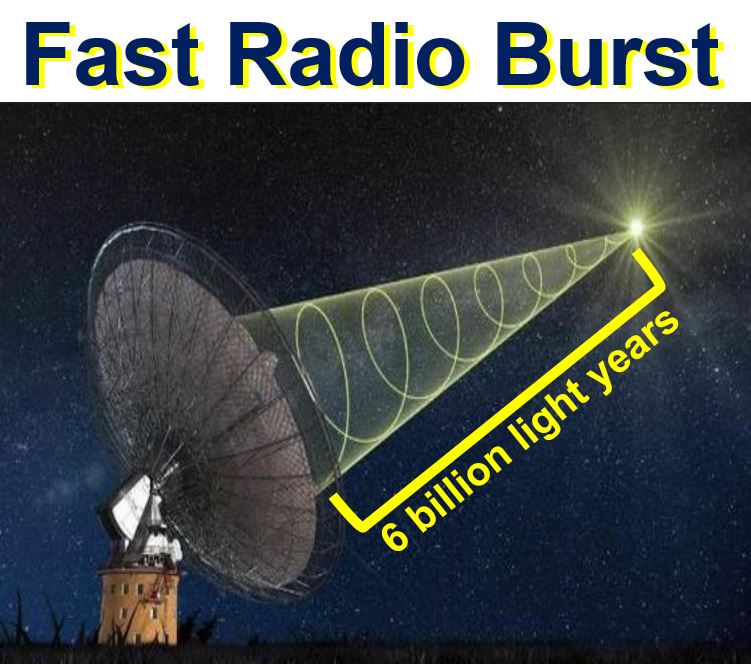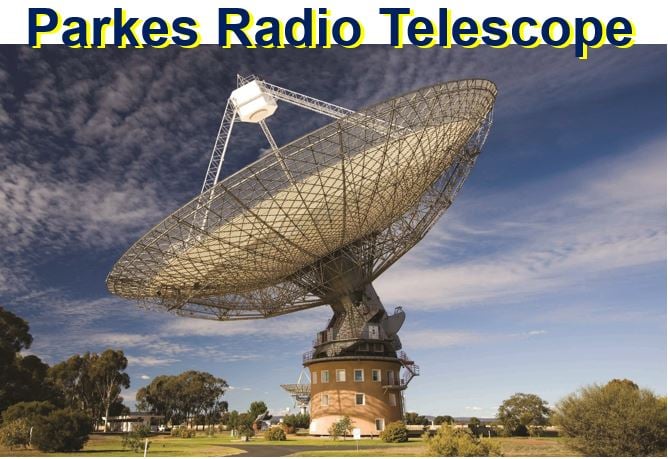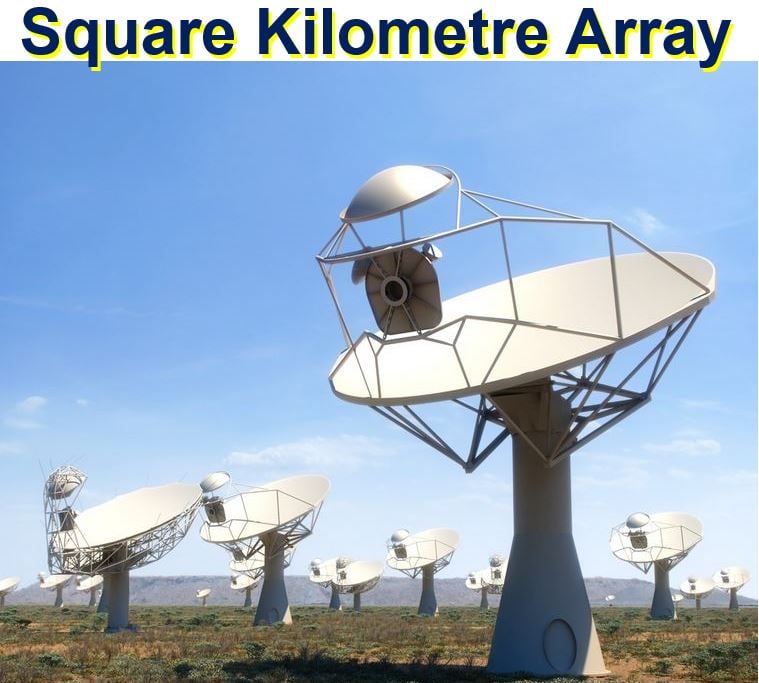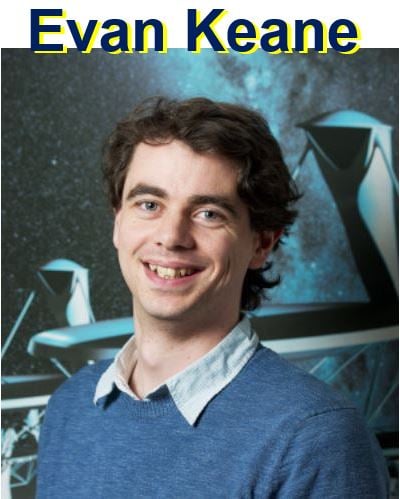A mysterious fast radio burst has been pinpointed as coming from a galaxy 6 billion light years (1.9 billion parsecs) away. Curious bright blasts of radio waves from the distant Universe that last just a few milliseconds have been detected by astronomers since 2007. Nobody knew where they came from, that is, until this latest study.
An international team of scientist says this is the first time the location of an FRB (fast radio burst) has been identified. They used a combination of radio and optical telescopes to identify its location, allowing them to confirm the current cosmological model of the distribution of matter in our Universe.
They wrote about their study and findings in the prestigious peer-review journal Nature (citation below).
 This latest FRB came from a galaxy 6 billion light years from Earth. It probably came from two colliding neutron stars, which spun around each other until they merged. It is the first FRB ever to be pinpointed.
This latest FRB came from a galaxy 6 billion light years from Earth. It probably came from two colliding neutron stars, which spun around each other until they merged. It is the first FRB ever to be pinpointed.
The Square Kilometre Array (SKA) is an effort involving several centres around the world to build the world’s biggest radio telescope, led by the SKA Organization at Jodrell Bank Observatory, which belongs to the University of Manchester.
SKA has brought together leading scientists, engineers and policy makers from several countries, and over 100 companies and research institution from 20 nations.
FRB detected last year
Last year, on 18th April, an FRB was detected by the Commonwealth Scientific and Industrial Research Organisation’s (CSIRO’s) 64-metre Parkes radio telescope in Australia. It immediately triggered an international alert to follow it up with telescopes elsewhere. Within a few hours, several telescopes around the world were looking for the signal, including CSIRO’s Australian Telescope Compact Array (ATCA).
FRBs are mysterious bright radio flashes that typically last just a few seconds and get astronomers super excited. Nobody knows where they come from. Suggestions as to their origins make a long list, including a collision between very dense objects like collapsing black holes or neutron stars, hyperflares of magnetars, or black hole explosions. Some people believe they come from intelligent alien civilisations.
 The Parkes Radio Telescope (Parkes Observatory) is located in New South Wales, Australia. With a diameter of 64 metres, it is one of the largest single-dish telescopes in the southern hemisphere dedicated to astronomy. It was the first telescope to pick up this latest FRB. (Image: csiro.au)
The Parkes Radio Telescope (Parkes Observatory) is located in New South Wales, Australia. With a diameter of 64 metres, it is one of the largest single-dish telescopes in the southern hemisphere dedicated to astronomy. It was the first telescope to pick up this latest FRB. (Image: csiro.au)
FRBs are extremely hard to detect – before this latest discovery, only sixteen had been detected.
Lead scientist behind the study, Dr. Evan Keane, Project Scientist at the Square Kilometre Array Organisation, said:
“In the past, FRBs have been found by sifting through data months or even years later. By that time it is too late to do follow up observations.”
Detecting FRBs immediately
To remedy this problem, the team developed its own observing system to detect FRBs within seconds of receiving them, and to alert other telescopes straight away, where there is still time to search for further evidence following the initial flash.
Thanks to ATCA’s six 22-metre dishes and their combined resolution, the scientists were able to determine where the signal came from with much greater accuracy than has ever been possible. They detected a radio afterglow that lasted for about six days before it faded away.
This afterglow enabled the team to determine where the FRB came from with about one thousand times the precision than before.
Co-author Benjamin Stappers, Professor of Astrophysics at The University of Manchester, said:
“The key to this project was the rapid localisation of the FRB and identifying the host galaxy. Discovering more FRBs will allow us to do even more detailed studies of the missing matter, and perhaps even study dark energy.”
“To do this, we are starting projects with arrays of telescopes like e-MERLIN and MeerKAT, which will allow us to have a localisation directly from the burst itself.”
 An artist’s rendition of the Square Kilometre Array (SKA) mid dishes in Africa shows how they may eventually look when completed. The 15m-wide dish telescopes will provide the SKA with some of its highest resolution imaging capability. When completed, the telescopes (in Australia and South Africa) will have a total collecting area of one square kilometre. (Image: skatelescope.org)
An artist’s rendition of the Square Kilometre Array (SKA) mid dishes in Africa shows how they may eventually look when completed. The 15m-wide dish telescopes will provide the SKA with some of its highest resolution imaging capability. When completed, the telescopes (in Australia and South Africa) will have a total collecting area of one square kilometre. (Image: skatelescope.org)
The astronomers then used the National Astronomical Observatory of Japan’s (NAOJ’s) 8.2-metre wide Subaru optical telescope in Hawaii to look at where the FRB came from, and identified an elliptical galaxy about 1.9 billion parsecs (6 billion light years) away.
First FRB ever pinpointed
Dr. Keane said it was the first time anybody had been able to identify an FRB’s host galaxy. The optical observation also gave the scientists the speed at which that galaxy is moving away from us due to the accelerated expansion of our Universe – the redshift measurement – the first time a distance for an FRB has been determined.
FRBs show a frequency-dependent dispersion – a delay in the radio signal which depends on how much material it has travelled through.
Co-author, Dr Simon Johnston, from CSIRO’s Astronomy and Space Science division, said:
“Until now, the dispersion measure is all we had. By also having a distance we can now measure how dense the material is between the point of origin and Earth, and compare that with the current model of the distribution of matter in the Universe. Essentially this lets us weigh the Universe, or at least the normal matter it contains.”
 Dr. Evan Keane is the project scientist at the Square Kilometre Array allocated to the Pulsars, Transients and Solar/Heliopheric science working groups and the CSP and SaDT design consortia. His scientific research includes neutron stars, black holes and fast radio bursts. (Image: skatelescope.org)
Dr. Evan Keane is the project scientist at the Square Kilometre Array allocated to the Pulsars, Transients and Solar/Heliopheric science working groups and the CSP and SaDT design consortia. His scientific research includes neutron stars, black holes and fast radio bursts. (Image: skatelescope.org)
In the current model, the Universe is believed to consist of 70% dark energy, 25% dark matter and 5% ordinary matter. Ordinary matter refers to everything we can see.
Missing matter found
However, through observations of galaxies, stars and hydrogen, scientists have only been able to account for around half of the ordinary matter, the rest has been referred to as ‘missing’ because it could not be seen.
Regarding this missing matter, Dr. Keane said:
“The good news is our observations and the model match, we have found the missing matter. It’s the first time a fast radio burst has been used to conduct a cosmological measurement.”
The scientists expect the Square Kilometre Array – with its extreme sensitivity, resolution and wide field of view – to detect hundreds of FRBs and tell us where they came from.
A much larger sample will allow us to make more precise measurements of cosmological parameters, such as the distribution of matter in our Universe, and give us a better understanding of dark energy.
The galaxy where this FRB came from is relatively old, and so very rarely makes new stars. Because of that, Dr. Keane and colleagues believe that the FRB came from two colliding neutron stars, which orbited each other and got closer and closer until they merged.
The brevity of the FRB is consistent with the estimated timescale for such an event, rather than a collision between bigger objects, such as white dwarves, or a massive supernova.
Mark Zastrow, writing in Nature News, quotes astronomer Kiyoshi Masui of the University of British Columbia in Vancouver, Canada, who said “[The discovery is the] measurement the field has been waiting for.”
By finding more such FRBs and measuring the distance of where they came from, scientists hope to use the signals as beacons to shed light on the evolution of the Universe.
Citation: “The host galaxy of a fast radio burst,” M. Berezina, M. Mickaliger, C. Bassa, E. F. Keane, S. Johnston, S. Bhandari, E. Barr, N. D. R. Bhat, M. Burgay, M. Caleb, C. Flynn, A. Jameson, R. Wayth, P. Chandra, D. Perrodin, M. Kramer, E. Petroff, A. Possenti, D. L. Kaplan, S. J. Tingay, A. Williams, W. van Straten, M. Bailes, S. Burke-Spolaor, R. P. Eatough, B. W. Stappers, J. Cooke, J. Jencson, M. M. Kasliwal, T. Totani, M. Honma, H. Furusawa, T. Hattori, N. Yasuda, R. Allen, T. Morokuma, Y. Niino, H. Sugai, S. Yamasaki, T. Terai & N. Tominaga. Nature 530, 453–456. 25 February 2016. DOI:10.1038/nature17140.
Video – Origins of Fast Radio Bursts
This video, from Carnegie Mellon University, was published before the latest FRB that was pinpointed.

